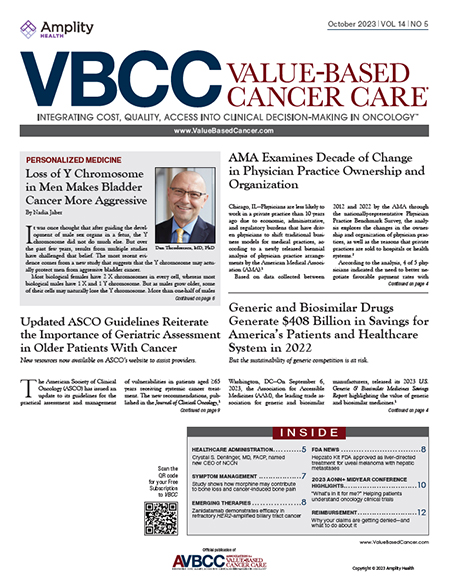Real-world analysis of patients with MM determines treatment patterns and survival outcomes in patients with t(11;14) compared to patients with high- and standard-risk cytogenetics.
Although there are recent advances in the multiple myeloma (MM) therapeutic landscape, 5-year overall survival (OS) in patients with translocation of chromosomes 11 and 14 (t[11;14]) is still only approximately 5%. Outcomes can be affected by a variety of factors, which include patient characteristics such as age and fitness, race, and genetic abnormalities specifically involving chromosomes 14, 1p, 1q, 13, or 17. Based on cytogenetic abnormalities, there are several risk subgroups of patients with MM. t(11;14) occurs in approximately 16% of patients and is historically considered a “standard-risk” abnormality; however, recent findings may suggest a poorer prognosis in these patients than previously expected. There is currently no clear understanding as to how the prognostic implications of t(11;14) inform therapeutic treatment options and the development of targeted therapies. Atrash and colleagues published findings from retrospective data using a real-world database that examined primarily community-based treatment patterns and outcomes in patients with t(11;14) compared to high- and standard-risk subgroups (including those patients with co-occurrence of t[11;14]) across different lines of therapy.
A total of 6138 patients were eligible and included in the MM cohort from January 2011 to January 2020. Of these, 6137 patients received first-line therapy, 3160 received second-line treatment, and 1654 received third-line treatment. In the first-line cohort, 4614 patients had available data for risk stratification; 55% were grouped as standard risk, 35% high risk (per mSMART criteria), and 10% t(11;14)+ (patients with t[11;14] and no co-occurring high-risk cytogenetics). Of the high-risk patients, 14% also harbored t(11;14). Bortezomib, lenalidomide, and dexamethasone (VRd) was the most common first-line treatment across all cytogenetic risk groups (40% of patients), and VRd and lenalidomide + dexamethasone were the most common second-line treatment options across risk groups. Third-line treatment options were more fragmented given the larger number of approved treatment options; however, daratumumab and elotuzumab were prescribed more frequently in the third line compared to earlier lines. As patients advanced to later lines, the use of triplet therapy decreased. Patients received similar treatments in each line of therapy with different cytogenetic risk. In the first-line setting, 85% of high-risk patients, 79% of t(11;14)+ patients, and 78% of standard-risk patients received a proteasome inhibitor (PI)-containing regimen. In the second line, 63% in the high-risk group, 62% in the t(11;14)+ group, and 59% in the standard-risk group received a PI-containing regimen. In the third line, the use of a PI-containing regimen was slightly lower in the high-risk group versus t(11;14)+ and standard-risk groups: 49%, 58%, and 52%, respectively. Time to next treatment decreased in later lines of therapy and was shortest for patients in the high-risk group across all lines of therapy. Additionally, patients in the high-risk group had the poorest median OS compared to the t(11;14)+ and standard-risk groups in the first-line setting (48.9 months, 74.0 months, and 77.0 months, respectively).
Overall, similar treatment patterns were observed for patients who were t(11;14)+ compared to high- and standard-risk patients in the first- and second-line setting. Because t(11;14) is an early genomic event, there is an opportunity for future investigation into more personalized approaches to treatment in this patient population with the goal of improving outcomes relative to current treatment patterns.
Reference
- Atrash S, Flahavan EM, Xu T, et al. Treatment patterns and outcomes according to cytogenetic risk stratification in patients with multiple myeloma: a real-world analysis. Blood Cancer J. 2022;12:46.


